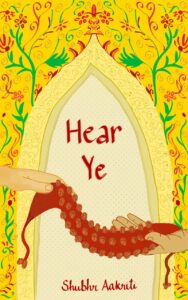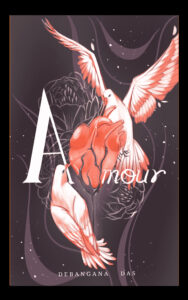Imagine this. You have finished the final draft of your book. It is lying there, on your laptop, perfectly typed.
And you can’t wait to share it with the world.
But there’s just one problem.
You have no idea what your book’s cover will look like.
Now they say we should not judge a book by it’s cover but at the end of the day, isn’t that the first impression your book has? And sometimes, first impressions can be the last one.
In the interest of helping you make the best cover for your book, we at Muses_Saga decided to share some tips, tricks, and hacks.
Voila!
Here’s what we at Muses_Saga do to help our artists make the best covers for your authors.
1. Sit down with the author
Any book begins with its author. They see the world and form a connection with an idea that takes up their time and mental space. A good cover honors that. While we don’t always do this at the start of the process of cover making, our authors get the final say for every book.
So, the author and artist need to sit down together and create a vision of what the cover shares about the book. A theme? An idea? The characters? A scene?
Which leads into the step which every author should keep in mind when making a book cover. What goes on the cover. And here’s some things you can put on your book’s cover.
Pick a motif from your book
What is a motif?
It is a recurring image that is important to your book. It can be a symbol of something, a way to depict a theme, or more.
Another example, is Muses_Saga’s upcoming novel, Hear Ye. When the author, Tripti Jain, and I were discussing the cover, the idea that the ghungaroo, an important aspect of one of the main characters’ life, would be on the cover was a no-brainer. The fact that book is a love story just meant they had to be exchanged between the two protagonists.

But there are other ways for symbolism to be part of your book’s cover. Let us explore a few.
Use Symbolism
While we have covered symbolism in motifs. But let’s get back to it for a moment. Because other than motifs, you can use symbolism and abstract art to show a theme or an idea from the book. Think, the cover of Siya: A Suicide’s Argument. It is a woman on strings like a puppet. While not abstract, it shows the inherent idea of not being in control of your life that Siya feels throughout the book and works to change.

It sets the tone of the book and gives readers an idea of what to expect, which is an important task for a cover to accomplish.
And of course, the language of colours, both integral to the story and universe you have created, as well as those which have meaning in the “real” world is important. But before we got to that, we are going to look at what else a cover can be.
Go for a scene or a set of characters from the book
Just like the scene, you can also go for characters from a book, especially if they are in the middle of an important scene. Think cover of The Hobbit, with the scene where Bilbo is leaving for the adventure on the cover. Or Bilbo holding sting. The protagonist on the cover is always a crowd pleaser.
You can also use important settings from the book as the cover. An example, would be using the doors of Moria or Erebor as a cover for the Fellowship or the Ring or The Hobbit. Even better, using Bilbo’s green door as a cover for The Hobbit. These are all setting people have come to love because of the significance they hold in the story.
You can also use abstract art or just texts on a black of colour.
But what type of cover you create depends on a lot of factors. Trpti Jain weighs in with some considerations she has when making a book cover, apart from the author’s vision.
Genre of the book
While genre is more about marketing and shelving books, Tripti Jain says it is important when making a cover, to ensure you convey the right mood and vibes to the target audience. If you choose to go down this route, you can see what others book with similar ideas and genre have done. This can help you find your people who like the kind of books you right. And beyond the genre, the setting, time period, and such of the book, can also be incorporated into the cover to ensure the book lands in the right hands. For example, a fantasy set in pre-independence India can be easily conveyed by the cover showing something that is associated with British India. This allows those who enjoy books set in that time period to know yours is a book they would like.
But alongside the setting and genre, Tripti Jain, says another thing is important. The vibe of the book/
Mood of the text
The perfect example for this would be Siya: A Suicide’s Argument. The dark mood of the book, is conveyed by the muted and somber colours and strokes, which conveys to the readers the serious nature of the book. Tripti Jain also says that the colour scheme and typography should be in sync with the theme of the book, and we urge you to add the mood to it as well.
And it’s not just not only about what your cover looks like and what it conveys. There’s a lot more that goes into making one, especially if you are looking to create something eco-friendly. One aspect to making a book sustainable and the cover effective is the management of space. Extra and unnecessary space can be bad for aesthetic and as such wasteful, which is neither eco-friendly nor pretty. Therefore, it is essential to manage the space of your cover.
Managing white space and the spine
An important aspect of making a book cover, according to Tripti Jain, is deciding what to do with the spine and the white space on the cover. This is dependent on the size of the book, the theme, the thickness of the book, and what the author wants to convey through the language of graphics and art. For example, in Impulses Laid Bare by Alexia, there is a lot of white space on the cover. It works because the cover is mostly in black and white with a dash of color here and there to indicate that people have hidden sides to them.
For the spine, many authors choose to go with their name or the book’s name on it. It can also be left blank though, as many authors here at Muses_Saga choose to do. And of course, in a chapbook, this cannot be changed for the spine is rarely thick enough to hold anything.
Another thing to note, is that the spine and the title, even the subtitle of the book, if the book is sold digitally have an important role to plat in terms of SEO. So, we must look at them in terms of keywords.
Keywords
Tripti Jain says an artist needs to look at the keywords and we agree. Placing the art in such a manner

where the keywords are highlighted, and the font conveys not only the pacing and strength of the book, but also is legible is important. All this after all, played an important role in the making of the cover of Muses_Saga’s upcoming publication, All About Loves.
Choose a blurb
Another important aspect to communicate the story of your book and also capitalize on SEO is your blurb. To begin with choose whether you want reviews on the back cover of the book or a small summary telling your story. Do you want an author’s picture or bio?
Readers generally prefer that there is a logline or a blurb telling you what the book is about…but if you feel SEO success using reviews from major publications serves you better, that’s your call. Or you can add art to the back cover as well, like Debangana Das and Andrilla Mitra did for Amor.

But it’s not just about the design and the text. For in a commercial book cover, you have to follow the word of the law as well.
Check the Legalities
Tripti Jain finally urges you to check with the legalities to ensure every piece you are using is in the public domain and none of the ideas are patented. This also helps us ensure important items like the ISBN and barcode are present on the back of the cover in the right manner, in my opinion.
This step is especially important as we don’t want a book banned because of its cover now do we?
Or do we?
Let us know in the comments below!
Author- Anjali Roongta
Beta Reader- Shubhr Aakriti
If you wish to help Muses_Saga keep reading free, you can buy our team a coffee or share this blog.
